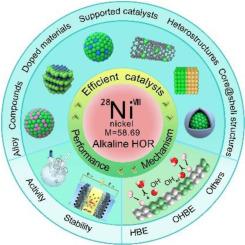Alkaline hydrogen oxidation reaction on nickel-based non-noble metal electrocatalysts
IF 36.6
Q1 ELECTROCHEMISTRY
引用次数: 0
Abstract
The anion exchange membrane fuel cell (AEMFC) enables the use of non-noble metal catalysts, greatly reducing the cost of fuel cells. Nickel-based materials are considered the most promising anode catalysts for practical applications in low-cost AEMFCs, but designing Ni-based catalysts with breakthrough performance remains a major challenge due to the slow kinetics of the anodic hydrogen oxidation reaction (HOR) in alkaline media. In this review, the electrocatalytic mechanisms of the alkaline HOR and the rigorous methods for assessing the performance of Ni-based catalysts are presented as the cornerstones for designing Ni-based catalysts. Alignment with the modulated geometric and electronic properties of Ni-based catalysts is thoroughly discussed, based on the principles of mechanism and performance evaluation. An element navigation map is presented to guide the precise design of efficient Ni-based non-noble metal catalysts for the alkaline HOR, and the current challenges and future prospects are outlined to provide valuable directions for new research about the alkaline HOR on Ni. This review not only offers insights into the rational design of Ni-based electrocatalysts but also provides a blueprint for the commercialization of cost-effective AEMFCs.

镍基非贵金属电催化剂上的碱性氢氧化反应
阴离子交换膜燃料电池(AEMFC)可以使用非贵金属催化剂,大大降低了燃料电池的成本。镍基材料被认为是低成本aemfc中最有前途的阳极催化剂,但由于碱性介质中阳极氢氧化反应(HOR)动力学缓慢,设计具有突破性性能的镍基催化剂仍然是一个主要挑战。本文综述了碱性HOR的电催化机理和ni基催化剂性能的严格评估方法,为ni基催化剂的设计提供了基础。从机理和性能评价的基本原理出发,深入探讨了镍基催化剂的几何和电子特性与取向的关系。提出了一种元素导航图,用于指导高效Ni基非贵金属碱性HOR催化剂的精确设计,并概述了目前面临的挑战和未来的展望,为Ni基碱性HOR的新研究提供了有价值的方向。这一综述不仅为镍基电催化剂的合理设计提供了新的思路,也为经济高效的aemfc的商业化提供了蓝图。
本文章由计算机程序翻译,如有差异,请以英文原文为准。
求助全文
约1分钟内获得全文
求助全文

 求助内容:
求助内容: 应助结果提醒方式:
应助结果提醒方式:


